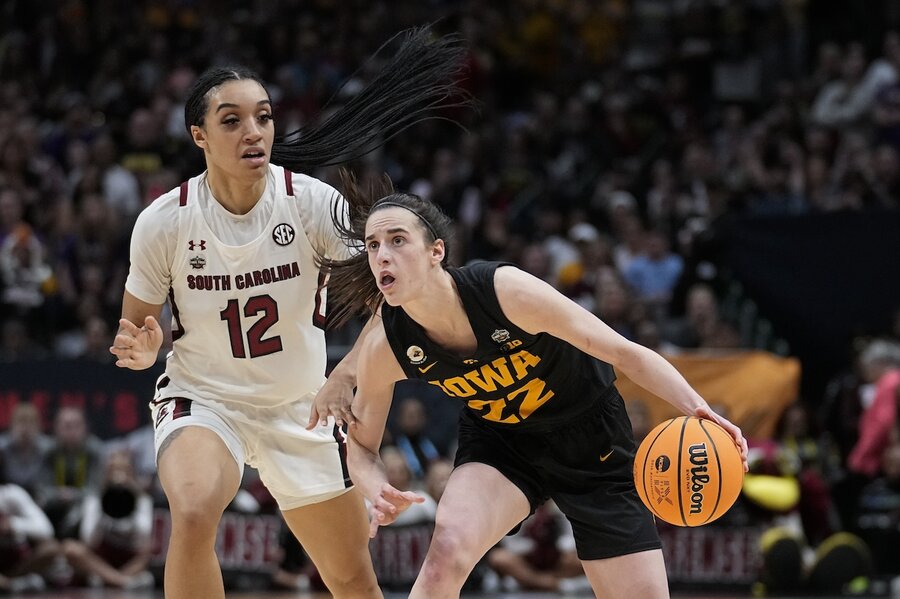March Madness: Women's NCAA tournament breaks new ground
Loading...
| Dallas
This year’s record-breaking women’s NCAA basketball tournament featured breakout stars and upsets and capped off with the flamboyant Kim Mulkey leading LSU to its first basketball championship.
Ms. Mulkey’s unforgettable outfits were just one of several memorable moments. There was Caitlin Clark’s 40-point triple-double in the Elite Eight game, the drama of South Carolina’s quest to complete the latest undefeated season, and two No. 1 seeds being knocked off before the Sweet 16.
It led to the highest attendance ever in the tournament’s history to go along with stellar TV ratings in every round. The timing couldn’t be better for the sport. It all could lead to women’s basketball getting a separate TV deal when the contract expires next summer.
Here’s a look at some of the top moments from the tournament:
Fiery fashionista
Ms. Mulkey is never hard to miss on the sideline with her feisty approach and reactions to referees and her players. The coach’s flamboyant attire takes her presence to a different level, and her Final Four outfits certainly stood out.
For the national semifinal game, Ms. Mulkey arrived in a carnation pink top with flower-like puffs along the entire sleeves, a designer-made top similar to what her 2-year-old granddaughter wore. Even the LSU mascot was spotted in pink attire.
The coach wore a sparkly, golden, tiger-striped outfit during the championship game. Her players were the golden girls, who won the first basketball championship in school history.
Dazzling Clark
Ms. Clark set an NCAA Tournament record by scoring 191 points over Iowa’s six games, surpassing Sheryl Swoopes’ 177 points for Texas Tech in 1993 – and Glen Rice’s 184 for Michigan in the 1989 men’s tournament.
Before 30 points in the championship game, the 6-foot Iowa-born Ms. Clark was the first player in the women’s tournament with back-to-back 40-point games. That included her 11th career triple-double in the regional final against Louisville, before another 41 points against previously undefeated South Carolina in the national semifinal game.
History denied
South Carolina was trying to become the 10th women’s team to run through a season undefeated and the first school to win consecutive titles since UConn won four straight from 2013-16. The Gamecocks were denied that chance, losing to Iowa in the Final Four behind a stellar effort from Clark.
End of an era
UConn’s run of 14 consecutive Final Four appearances came to an end in the Elite Eight when Ohio State forced the Huskies into 18 first-half turnovers with full-court pressure defense. The Huskies hadn’t missed playing in the national semifinals since 2007.
New format
The NCAA changed its regional format this year going to two sites instead of the traditional four. It got strong reviews from players and coaches and fans alike. There ended up being a record attendance for that round with more fans showing up in Seattle – which had no team within 1,300 miles of the venue – than Greenville, South Carolina.
‘Canes were cooking
Miami did more than just be part of history by knocking out No. 1 seed Indiana before the Sweet 16. The Hurricanes under coach Katie Meier ousted Villanova and ended national scoring leader Maddy Siegrist’s career to reach the Elite Eight for the first time. The champs from LSU ended Miami’s run with a muddy 54-42 win in the regional finals.
Thirst for firsts
Virginia Tech was a first-time participant in the Final Four, which had a pair of first-time finalists after LSU beat the top-seeded Hokies and Ms. Clark’s Hawkeyes ousted undefeated defending national champion South Carolina. It was already guaranteed before the final that the champion would be something other than a No. 1 seed for the first time since 2011.
Upsetting performances
Stanford and Indiana both fell in the second round becoming the second pair of No. 1 seeds to not make the Sweet 16 since the tournament expanded to 64 teams in 1994. It also happened in 1998. The Cardinals were stymied on their home court by Mississippi’s defense. They never led the second-round game and had their streak of 14 consecutive Sweet 16 appearances ended. The Hoosiers lost at Assembly Hall the next night, when Miami’s Destiny Harden made the game-winning shot with 3.5 seconds left.
This story was reported by The Associated Press. AP Sports Writer Stephen Hawkins and AP Basketball Writer Doug Feinberg contributed to this story.







